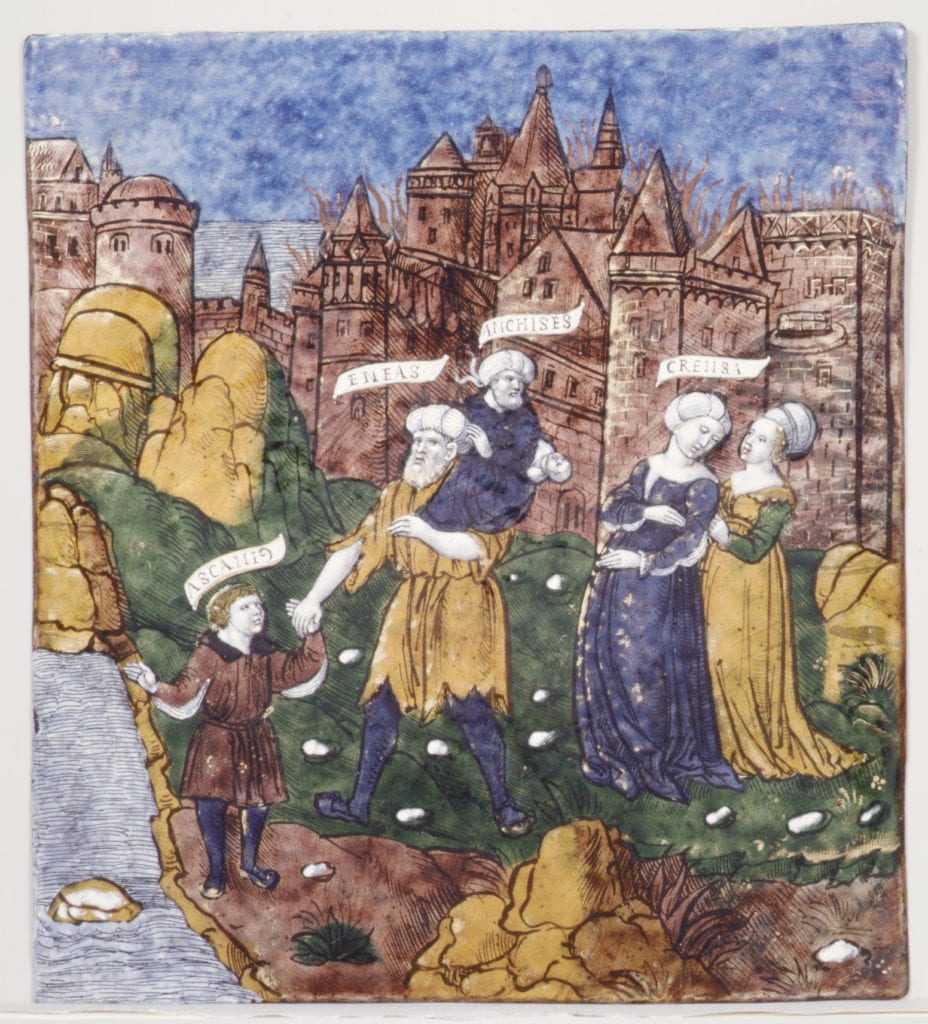Italy
Composed: 29-19 BCE
Virgil,
Aeneid
The Aeneid is a narrative poem in twelve bookrolls on the legendary origins of Rome that fully annexes the world of Greek mythological epic to the Roman thought-realm. More specifically, the Aeneid is a foundation story for the Roman empire, placing at the climax of history the leader, Augustus, who had presided over Rome’s final change from a constitutional republic to an autocracy. Yet those events are well outside the poem’s narrative, which recounts only the flight of Aeneas and his companions to Italy after the fall of Troy, not even reaching their initial settlement, let alone the foundation of Rome or the rise of Augustus, except through prophecies and other flash-forwards.
So the poem’s teleological burden is seldom carried by an epic narrator, but by subordinate voices, sometimes deeply enframed. Immediately after eleven lines of prologue we hear of the future clash between Rome and Carthage, but from the hostile goddess Juno’s viewpoint, couched within her concern over oracles about Rome’s coming supremacy. Destiny, however the characters treat it, is etymologically a function of speech: “fate” (fatum) is in dialogue with its cognate fama, which can signify fame, reputation, rumors, and report, and may simply reduce to “what is said.” In Book 4 fama is personified as a rumor-spreading monster, “as faithful a messenger of the fabricated and the wrong as of the true” (4.188): the Aeneid is conceptually talking about its own messages. A reader of the poem in English has no idea of the pervasive non-literalness of its very Latin: every translation of the Aeneid is simultaneously a reduction of its multivalent, allusive tropes into determinacy, and—as a glance at any school commentary will disclose—interpretive decisions bedevil nearly every line.
The poem begins with Aeneas’ group several years into their wanderings, forced by Juno to land near Carthage on the African coast. Books 2 and 3 are flashbacks as Aeneas himself tells the Carthaginians of the Greeks’ destruction of Troy (thus effecting a sequel to the Iliad) and his attempts to start a colony before oracles sent him westward (his adventures are often continuous with those of the Argonauts and Odysseus). In Book 4 Dido, the queen of Carthage, infected by Venus and Cupid with love for Aeneas in a perplexing plot to ensure her temporary assistance, ultimately kills herself when he resists her entreaties and departs for Italy at Jupiter’s command. During a layover in Sicily in Book 5 Juno intervenes again, inspiring the Trojan women to revolt against the continuing journey. In Book 6 the remaining group finally reaches Italy, and Aeneas descends to the Underworld with the Sibyl, where the ghost of his father Anchises teaches him about the Roman glory that is fated to come, yet is Aeneas’ responsibility to bring about. The poem’s second half involves battles of the Trojans and their local allies (notably the Greek Evander, who settled on the future site of Rome) against the Latins and their pan-Italian allies over the Trojans’ right to settle and the choice of Aeneas as husband for Lavinia, daughter of the Latins’ king Latinus. Just before the climactic battle in Book 12, Juno and Jupiter strike a bargain that the Trojans will lose their ethnic and cultural identity, melding entirely into the local people: with this, Juno drops her active hostility to Aeneas. With Jupiter’s support he defeats the local champion, Turnus, in single combat and kills him, despite some hesitation, when he sees the ornate swordbelt Turnus had taken after slaying Aeneas’ protégé, Evander’s son Pallas—and there the poem ends.
Before the Aeneid Vergil had composed the Eclogues (a collection of pastoral dialogues and monologues) and the Georgics (a didactic poem centered on agriculture). Both can be read, like the Aeneid, as about contemporary Roman concerns, although Vergil should not be seen anachronistically as a “court poet.” The Aeneid’s grand prophetic tableaux, however, do glorify Augustan Rome, often explicitly as inspiration for the characters, basing Augustus’ ascendancy on Hellenistic monarchic values of benefaction and world conquest as well as on destiny and divine ancestry: in Book 1 Jupiter’s reassurance to Venus—Aeneas’ mother—of her progeny’s victory; in Book 6 Anchises’ display of spirits in the Underworld waiting to be reincarnated as heroic Romans; in Book 8 the future site of Rome and the description of Aeneas’ shield, crafted by Vulcan to depict events from Roman history, including Augustus’ decisive defeat of Antony and Cleopatra and subjugation of eastern and western realms to Rome (this poem, however its modern reception has reconstrued its conceptual Roman self, does not make room for a general “western” identity). These predictions let Rome subsume and supersede earlier empires’ claims of divinely favored supremacy, but the Aeneid always couches them in contestable speech. Jupiter’s predictions, responding to Venus’ hopes and fears, conflict with information elsewhere in the poem (and outside it) and show a degree of rhetorical slipperiness and manipulation. Anchises’ “pageant of heroes,” tracing Roman leadership from its Trojan roots, is tendentiously calculated to interpellate his still-Trojan son into a teleology leading to the reign of Augustus, whose rulership Anchises celebrates midway through his exposition. The allusions to the Roman future during the competitions in Book 5 (in the mouth of the Vergilian narrator) rather emphasize the corporate power of an aristocracy traced back to Troy and projected onto the Roman Republic—and belie Jupiter’s seeming pact with Juno that Trojan identity will wholly die out from Rome. The images on the shield represent in Vergil’s words a Roman history that Vulcan learned from vates, “seers” or “inspired poets” (8.626): they reach the reader through three levels of report. The poem remains an open text, offering no fixed interpretive center.
The Aeneid’s very justification of Aeneas’ mission—and ultimately of Roman imperium—is inextricable from the authority of embedded prophecy and report. What directs Aeneas to Italy is the inconspicuous Etruscan city of Corythus where, according to the Penates’ interpretation of Apollo’s oracles (3.163-71) and a story Latinus attributes to “Auruncan elders” (7.205-11), Aeneas’ ancestor Dardanus originated. Although this provenance wins Aeneas a claim to Italian land, it should deny him one to lead the Etruscans in battle, which according to another oracle (reported by Evander at 8.502-3) only a non-Italian can do. Aeneas’ marriage to Lavinia, the basis for the joint Trojan-Latin heritage of Rome, poses similar riddles: an oracle commanded Latinus to find a son-in-law among “foreign bridegrooms” (7.96-101). If origins matter—as one expects in this foundation epic—Aeneas may settle in Italy, but may not marry Lavinia, which is also necessary for the Roman future. Or else Dardanus’ Etruscan origin makes Aeneas eligible to marry Lavinia, but should disqualify him from leading the Etruscans, and leaves a geographical gap between the source, Corythus, and the destination, Rome. Or else the oracles are wrong—or wrongly reported. One critical response to the poem’s ambiguities has been to propose that Vergil would have reconciled inconsistencies in a final revision, but the puzzles we are looking at tend consistently to problematize Roman origins and destiny. No one perspective will be sufficient for the narrative to make sense.
A question frequently raised in contemporary scholarship on the poem is to what extent the poem undermines its evidently triumphalist teleology through sympathy with victims of Rome’s imperial advance, such as Dido and Turnus—“sympathy” here being an affective trope, provisional and contingent, although potentially disruptive to any Augustus-centered or even Rome-centered reading. The Aeneid’s often-perceived tone of wistful melancholy and troping of foundation as desire—personal love sublimated into a yearning for the Roman future, amor into Roma (with Venus as patron goddess)—produce ambivalent effects, further complicated by the poem’s own sensuous metaphorics. Its pervasive visuality—the virtually cinematic variety of its enargeia—draws the reader into multiple viewpoints on the action. Throughout Book 4 the strength of Dido’s own perspective on her agony, especially in contrast to the more opaque portrayal of Aeneas’ devotion to duty, keeps us from seeing her and her people as simply alien or hostile. The complex interchange of viewpoints likewise makes us see and feel with Turnus in passages like the remarkable nightmare simile in 12.908-12. The ending of the Aeneid is a key passage for critics who debate whether the poem ultimately shows Aeneas failing the high standards of self-control and clemency urged by Anchises in 6.853, parcere subiectis, “spare the defeated”—or conversely shows him fulfilling Anchises’ follow-up, debellare superbos, “battle down the proud.” And this interpretive choice has consequences for reading the poem’s assessment of Rome’s global and historical mission to paci imponere morem, roughly “add civilized order to pacification”—also Anchises’ words there, in his injunction to “the Roman” to “rule imperially over the nations” (6.851-2). Despite the Roman-Italian unity depicted on Aeneas’ shield, the Aeneid’s Italy—like the asylum that will become Rome (8.342)—is a destination for colonists from everywhere as well a homeland of diverse peoples, as our sympathy with the poem’s victims on both sides of the conflict should remind us. As teleology, this imperial embrace is homogenizing; as etiology it is multiethnic and plural. By keeping origins in view, the Aeneid offers ways to reopen and disaggregate imperial tropes of unity, and lays bare an image of invented tradition: except in transparent tropes of hindsight, the poem never closes off the paths not taken.
Joseph D. Reed
Brown University
Resources
Translations:
Ahl, F. 2007. Virgil: Aeneid. Oxford: Oxford University Press.
Bartsch, S. 2021. The Aeneid. Vergil. New York: Random House.
Heaney, S. 2016. Aeneid Book VI. New York: Farrar, Straus and Giroux.
Ruden, S. 2021. The Aeneid. Vergil. 2nd ed. New Haven: Yale University Press.
Select critical studies:
Farrell, J. 2021. Juno’s Aeneid: A Battle for Heroic Identity. Princeton: Princeton University Press.
Fletcher, K. F. B. 2014. Finding Italy: Travel, Nation, and Colonization in Vergil’s Aeneid. Ann Arbor: University of Michigan Press.
Giusti, E. 2018. Carthage in Virgil’s Aeneid: Staging the Enemy under Augustus. Cambridge: Cambridge University Press.
Hejduk, J., ed. 2017. Happy Golden Anniversary, Harvard School! = Classical World 111/1.
Hexter, R. 1990. “What Was the Trojan Horse Made Of?: Interpreting Virgil’s Aeneid.” Yale Journal of Criticism 3.2: 109-31.
Johnson, W. R. 1976. Darkness Visible: A Study of Vergil’s Aeneid. Berkeley: University of California Press.
O’Hara, J. J. 1990. Death and the Optimistic Prophecy in Vergil’s Aeneid. Princeton: Princeton University Press.
Panoussi, V. 2009. Greek Tragedy in Vergil’s Aeneid: Ritual, Empire, and Intertext. Cambridge: Cambridge University Press.
Parry, A. 1963. “The Two Voices of Virgil’s Aeneid.” Arion 2/4:66-80.
Putnam, M. C. J. 1965. The Poetry of the Aeneid. Harvard: Harvard University Press.
Reed, J. D. 2007. Virgil’s Gaze: Nation and Poetry in the Aeneid. Princeton: Princeton University Press.
Selden, D. 2006. “Virgil and the Satanic Cogito,” in S. Spence and M. Lowrie, eds., The Aesthetics of Empire and the Reception of Virgil = Literary Imagination 8/3: 345–86.
Thomas, R. F. 2001. Vergil and the Augustan Reception. Cambridge: Cambridge University Press.
The above bibliography was supplied by Joseph D. Reed (Brown University).
The Aeneid. Columbia College, The Core Curriculum, Explorations.
Prof. Donna Wilson (Brooklyn College, CUNY) has placed various Aeneid-related teaching and student materials online, beginning with Aeneid 1.
A reading of the opening of the Aeneid in Latin by John Kirby can be downloaded from First Lines: A Project in Global Diversity (Charles Ross, Purdue University).

